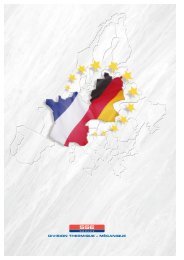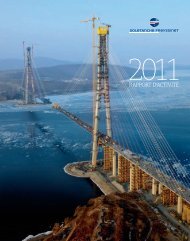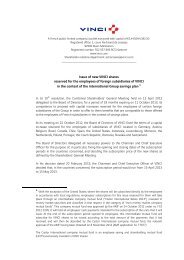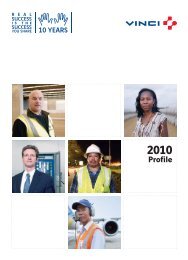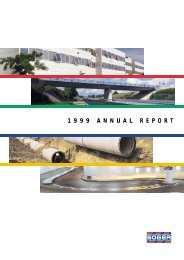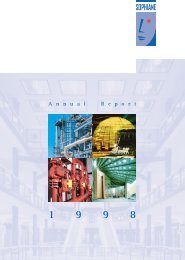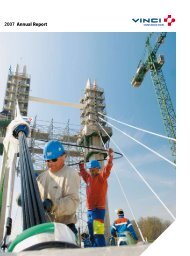VINCI - 2005 annual report
VINCI - 2005 annual report
VINCI - 2005 annual report
Create successful ePaper yourself
Turn your PDF publications into a flip-book with our unique Google optimized e-Paper software.
The third step, in 2003 and 2004, involved listing the risks and associated<br />
controls. The objective here was to use the self-assessment questionnaires<br />
and the interviews conducted with <strong>VINCI</strong>’s General Management, the<br />
managers of the main business lines and <strong>VINCI</strong>’s functional departments<br />
to list the main risks and corresponding controls existing within the<br />
Group and the business lines. This resulted in the identifi cation of the<br />
processes that the various entities should assess from an internal control<br />
viewpoint. Acceptance of new business was identifi ed as the main area to<br />
be assessed as a priority. The main risks inherent in the Group’s activities<br />
are analysed in the “Risk Management” section of the <strong>annual</strong> <strong>report</strong>.<br />
In 2004, the decisions taken in 2003 on the improvement of the internal<br />
control environment were implemented:<br />
– distribution of the Chief Executive’s guideline (see paragraph 3.3) to<br />
all the operational and functional managers of business lines in France<br />
and abroad;<br />
– harmonisation and fi ne-tuning of the formalisation of certain procedures<br />
(through the creation of working groups and specifi c dedicated<br />
resources), including in particular cash management and accounting<br />
5.2. WORK PERFORMED IN <strong>2005</strong><br />
The survey made in <strong>2005</strong> to assess the quality of internal control under<br />
the Financial Security Act covered 193 Group entities (including 38<br />
foreign entities) which replied to 120 questions grouped into three selfassessment<br />
questionnaires (internal control of operations and monitoring<br />
business; control of fi nancial information; the control environment and<br />
risk assessment). The three questionnaires used in previous years were<br />
fi rst simplifi ed and clarifi ed by a working group of experts from the<br />
Group’s various business lines. Analysis was made using various criteria:<br />
division, business line, geographical area, revenue.<br />
This survey showed that satisfaction with the quality of internal control<br />
increased on average by 8% for the Group against 2004.<br />
Furthermore, an assessment of the operation of the information systems<br />
has been launched in a representative sample of entities. These will complete<br />
a self-assessment questionnaire comprising four sections:<br />
– the information systems environment;<br />
– acquisition, development and deployment of software and hardware;<br />
– operation;<br />
– information systems security;<br />
This work will continue in 2006.<br />
Internal control in the Construction division is performed at the level of<br />
each of its sub-divisions: Sogea Construction, GTM Construction, <strong>VINCI</strong><br />
Construction Grands Projets, <strong>VINCI</strong> Construction Filiales Internationales,<br />
Freyssinet, <strong>VINCI</strong> PLC (UK) and CFE (Belgium). Each sub-division sets up<br />
its own system adapted to its organisation and business, the area where<br />
it operates and the size of its sites. Internal control arrangements are<br />
therefore well suited to a given entity but in general scarcely applicable to<br />
another one. An entity such as <strong>VINCI</strong> Construction Grands Projets, which<br />
is certifi ed ISO 9001 and 14001, has long since implemented rigorous<br />
REPORT OF THE CHAIRMAN<br />
at holding company level and a complete revision of operational procedures<br />
in the Roads business line; holding company procedures have<br />
also been made available on the Group’s intranet;<br />
– implementation in certain foreign subsidiaries of management methods<br />
and procedures complying with Group policy;<br />
– creation of internal audit functions in those business lines where none<br />
existed (Concessions and Energies) and an increase of business lines’<br />
head-offi ce management control staff;<br />
– implementation of a charter in the largest operational entity of the<br />
Construction business line (Sogea Construction), covering its ten<br />
internal operating rules (on risk taking, fi nancial engineering, outside<br />
appointments or functions, acquisition or disposal of securities and<br />
reorganisation, property and other tangible assets, human resources,<br />
budgetary management, banking relations and fi nancial commitments,<br />
administrative management, media – brands and logos);<br />
procedures that are applied well. Purely French entities, such as Sogea<br />
Construction, have made great efforts to strengthen their internal control,<br />
in particular as regards the formalisation and appropriate dissemination<br />
of operating rules. The procedures also now include constant verifi cation<br />
of compliance with the terms of the charter (see paragraph 5.1 above).<br />
In <strong>2005</strong>, <strong>VINCI</strong> Construction has sought to strengthen internal control<br />
in its Central and Eastern European subsidiaries (in Poland, Hungary, the<br />
Czech Republic, etc.) and this will continue in 2006.<br />
The Energies division has fi nished drawing up the fi rst part of a set of<br />
rules applicable to all its entities. This relates in particular to the internal<br />
control policy and organisation within the division. A second part,<br />
involving the drafting of procedures on 18 processes it considers have<br />
priority (e.g. acceptance of orders and debt collection), will be completed<br />
in 2006.<br />
The <strong>VINCI</strong> Energies internal audit department formed at the end of 2004<br />
carried out 27 assignments in <strong>2005</strong>.<br />
<strong>VINCI</strong> Concessions formed its internal audit department at the end of<br />
2004. While following each of the division’s specifi c activities, the initial<br />
internal audit work programme looked at those entities that were considered<br />
as having the greatest autonomy rather than the sectors making<br />
the largest contribution to profi ts. The objective of these fi rst assignments<br />
was therefore to determine the situation in entities that were sometimes<br />
far from the centre. Future assignments will focus more on monitoring<br />
implementation of the division’s procedures on a recurring basis.<br />
<strong>VINCI</strong> Concessions conducted 12 internal audits in <strong>2005</strong>, at Cofi route<br />
(1), <strong>VINCI</strong> Park (4), Airport Services (4) with 3 in the other concessions.<br />
In general, the audits confi rmed the implementation, within the entities<br />
audited, of the division’s internal control procedures regarding develop-<br />
173




